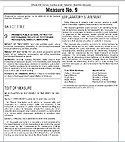Milestones in Oregon LGBTQ Law
(Click here to download this article as a PDF file.)
By George T. Nicola
June 16, 2015
This article is meant to give a brief description of some major laws, court decisions, and other governmental actions that could have in some way positively affected the lives of gay, lesbian, bisexual, or transgender (LGBT) Oregonians. I have no way of knowing how these actions are interpreted or to what extent they are still in effect. For instance, I do not know what effect the statewide laws have had on the similar local ordinances that had passed previously. I am not trained in law, and this document is not intended to be a source of legal advice or analysis. If you have a question about legal rights, please contact a legal professional.
If you believe you are the victim of discrimination based on your sexual orientation or your gender identity, please contact the Oregon Bureau of Labor’s Civil Rights Division through http://www.oregon.gov/boli/CRD/Pages/C_Crcompl.aspx.
If you discover any inaccuracies in this article, or if you suggest any additions, please contact GLAPN at info@glapn.org and we will review your input.
1972: Oregon criminal code revision
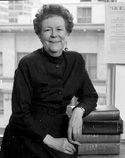 Oregon had long maintained a law that effectively criminalized most private and consensual homosexual conduct among adults. With help from the American Civil Liberties (ACLU) of Oregon, the law was changed considerably through a criminal code revision which took effect in 1972. The bill was signed into law by Governor Tom McCall, a Republican.
Oregon had long maintained a law that effectively criminalized most private and consensual homosexual conduct among adults. With help from the American Civil Liberties (ACLU) of Oregon, the law was changed considerably through a criminal code revision which took effect in 1972. The bill was signed into law by Governor Tom McCall, a Republican.
Stevie Remington (right) was Executive Director of the ACLU of Oregon from 1970 to 1992.
Governor Tom McCall (below, right).
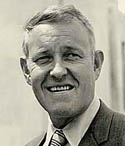 Under the new statute, generally no sexual conduct is illegal as long as it is noncommercial, private, and among consenting adults. However, the statute provided a misdemeanor category for soliciting “deviate” sex in public: “A person commits the crime of accosting for deviate purposes if while in a public place he invites or requests another person to engage in deviate sexual intercourse.” This provision was declared unconstitutional in 1981.
Under the new statute, generally no sexual conduct is illegal as long as it is noncommercial, private, and among consenting adults. However, the statute provided a misdemeanor category for soliciting “deviate” sex in public: “A person commits the crime of accosting for deviate purposes if while in a public place he invites or requests another person to engage in deviate sexual intercourse.” This provision was declared unconstitutional in 1981.
1973: Burton v. Cascade School District Union High School No. 5
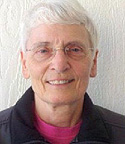 Peggy Burton was a school teacher in a small town near Salem. In 1971, she was fired from her job on the basis of “immorality”, after she was asked if she was a homosexual and she replied in the affirmative. She challenged the case with the help of the American Civil Liberties (ACLU) of Oregon and ACLU associated attorney Charlie Hinkle.
Peggy Burton was a school teacher in a small town near Salem. In 1971, she was fired from her job on the basis of “immorality”, after she was asked if she was a homosexual and she replied in the affirmative. She challenged the case with the help of the American Civil Liberties (ACLU) of Oregon and ACLU associated attorney Charlie Hinkle.
Peggy Burton (right).
 Here is the outcome of the case as explained by Hinkle:
Here is the outcome of the case as explained by Hinkle:
The federal District Court in Portland ruled that the dismissal was "wrongful" and it awarded her $10,000 in damages, plus a modest amount of attorney fees to the ACLU. However, the court refused to reinstate her to her old position, on the ground that reinstatement "would not work" in the small community of Turner, Oregon. Burton appealed to the Ninth Circuit Court of Appeals, which upheld that decision by a 2 to 1 vote.
This was an early and very important legal precedent against anti-gay employment bias.
1974: City of Portland resolution banning discrimination in city employment
 Today’s large Oregon LGBT movement began with a few small local gay political organizations in the early 1970s. Activists soon realized that protection from job bias was a major concern.
Today’s large Oregon LGBT movement began with a few small local gay political organizations in the early 1970s. Activists soon realized that protection from job bias was a major concern.
Portland City Commissioner Connie McCready.
At that time, the City of Portland had no general civil rights ordinance to which we could append sexual orientation protection. But starting in 1972, gay activists tried to get the city to take a stand against anti-gay bias in city employment.
In December of 1974, according to The Oregonian newspaper, the City Council “adopted the city’s first resolution banning job discrimination on the basis of sexual orientation for city employees.” The resolution was sponsored by City Commissioner Connie McCready. The vote was 3-2, so we won by only one vote. There was very vocal opposition, yet I can find no recorded attempt to overturn it through a ballot measure.
1987: Oregon state executive order banning sexual orientation discrimination in state employment
 In 1987, Oregon Governor Neil Goldschmidt issued an executive order which banned discrimination based on sexual orientation in the executive department of state government. The Oregonian described the order as “dealing with sexual orientation and the state government workplace.” The newspaper elaborated that “This included both personnel actions and the delivery of services to the public. The order didn't apply to state employees not under Goldschmidt’s control, such as judicial workers.”
In 1987, Oregon Governor Neil Goldschmidt issued an executive order which banned discrimination based on sexual orientation in the executive department of state government. The Oregonian described the order as “dealing with sexual orientation and the state government workplace.” The newspaper elaborated that “This included both personnel actions and the delivery of services to the public. The order didn't apply to state employees not under Goldschmidt’s control, such as judicial workers.”
Harriet Merrick (right).
Unfortunately, the order was overturned by an initiative called Ballot Measure 8. Measure 8, sponsored by a group called the Oregon Citizens Alliance (OCA), also prohibited any state official in the future from requiring non-discrimination against state employees based on sexual orientation.
Harriet P. Merrick, a lesbian employee of the University of Oregon, took the new law to court in cooperation with the American Civil Liberties Union of Oregon. In Merrick v. Oregon, 1992, the Oregon Court of Appeals ruled Measure 8 unconstitutional because its effect was “to restrain the right of free expression.”
1989: Oregon hate crime law that includes sexual orientation
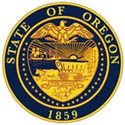 In 1989, the State of Oregon enacted a hate crime law that includes sexual orientation. Later, the law was amended so that sexual orientation includes gender identity.
In 1989, the State of Oregon enacted a hate crime law that includes sexual orientation. Later, the law was amended so that sexual orientation includes gender identity.
1991: City of Portland ordinance banning discrimination based on sexual orientation in employment, housing, and public accommodations
 In 1977, the City of Eugene passed an ordinance that banned discrimination based on sexual orientation in employment, housing, and accommodations. Unfortunately, the law was repealed by voters in Eugene Ballot Measure 51 the following year.
In 1977, the City of Eugene passed an ordinance that banned discrimination based on sexual orientation in employment, housing, and accommodations. Unfortunately, the law was repealed by voters in Eugene Ballot Measure 51 the following year.
Portland City Commissioner Mike Lindberg.
Keeston Lowery.
The City of Portland was the next jurisdiction to consider a similar law. In 1991, Portland passed an ordinance that The Oregonian reported banned “discrimination -- based on sexual orientation or source of income -- in housing, employment and public accommodations.” The ordinance was sponsored by City Commissioner Mike Lindberg. Helping Lindberg was his openly gay assistant, the late Keeston Lowery.
Portland’s passage of this type of law was 19 years after the first such ordinance in the country, adopted by the City of Ann Arbor, Michigan in 1972.
In Sims v. Besaw’s Café, January 2000, the Oregon Court of Appeals ruled that the City of Portland had a right to pass such an ordinance and that private parties must abide by it.
In the year 2000, gender identity was added to this ordinance.
1992: Multnomah County health benefits for domestic partners of county employees
 Multnomah County was the first public employer in Oregon to extend health benefits to domestic partners of county employees. The benefits became effective on July 1, 1993.
Multnomah County was the first public employer in Oregon to extend health benefits to domestic partners of county employees. The benefits became effective on July 1, 1993.
1992: The Defeat of Oregon Ballot Measure 9
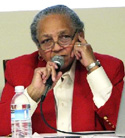 After their initial Measure 8 success, the Oregon Citizens Alliance (OCA) went on to sponsor Ballot Measure 9 in 1992. The measure was titled “Government Cannot Facilitate, Must Discourage Homosexuality, Other Behaviors.“
After their initial Measure 8 success, the Oregon Citizens Alliance (OCA) went on to sponsor Ballot Measure 9 in 1992. The measure was titled “Government Cannot Facilitate, Must Discourage Homosexuality, Other Behaviors.“
Lesbian activist Kathleen Saadat campaigned tirelessly against Ballot Measure 9.
Measure 9 would have amended the Oregon constitution to ban civil rights protection based on sexual orientation. It mandated that schools “shall assist in setting a standard for Oregon's youth that recognizes homosexuality, pedophilia, sadism and masochism as abnormal, wrong, unnatural, and perverse and that these behaviors are to be discouraged and avoided.” A section of the measure stating the government could not “promote, encourage, or facilitate homosexuality” could have had many negative results, such as banning gay positive books from public libraries.
Click on the image at right to open a readable version of the Measure 9 explanation from the 1992 Oregon Voters' Pamphlet.
Opposition to the measure was bipartisan and included people of many faiths, identities, and ethnicities. Gay men and lesbians came out to people they knew. Straight people increasingly realized that we are their friends, their family, their neighbors, their coworkers. Oregonians began to understand that when gay people as a group are being threatened, someone they love is probably being threatened. Voters defeated Measure 9 by an impressive 12.9% margin.
1993: House Bill 3500 voiding of local anti-gay measures
 Both before and after the statewide Measure 9, the Oregon Citizens Alliance also took local action. Initiatives similar to Measure 9 were placed on the ballots of about 29 Oregon cities and counties. However, it is difficult to arrive at exact details because there is no one primary online source to research local elections. The vast majority of measures passed, some by huge margins.
Both before and after the statewide Measure 9, the Oregon Citizens Alliance also took local action. Initiatives similar to Measure 9 were placed on the ballots of about 29 Oregon cities and counties. However, it is difficult to arrive at exact details because there is no one primary online source to research local elections. The vast majority of measures passed, some by huge margins.
Pioneering gay attorney Charlie Hinkle worked to defeat many of the anti-gay ballot measures.
These local initiative all appear to be similar to each other. Like the statewide measure, they forbad civil rights protection based on sexual orientation and prohibited public money from being spent to “promote” homosexuality. However, they apparently differed from the statewide initiative in that local measures did not always require an anti-gay curriculum in the schools.
In 1993, the Oregon Legislature invalidated these local measures with House Bill 3500, which prohibits local measures that “single out citizens or groups of citizens on account of sexual orientation.” The law was upheld by the Oregon Supreme Court in 1995.
1998: Tanner v. OHSU
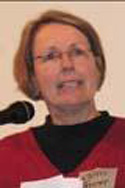 Christine Tanner was an employee of Oregon Health and Science University (OHSU). She wanted her employer to provide for her female partner the same health care benefits they provided for an employee’s spouse. OHSU would not comply. Tanner took the issue to court with the help of the ACLU of Oregon, and won a major victory.
Christine Tanner was an employee of Oregon Health and Science University (OHSU). She wanted her employer to provide for her female partner the same health care benefits they provided for an employee’s spouse. OHSU would not comply. Tanner took the issue to court with the help of the ACLU of Oregon, and won a major victory.
Christine Tanner (right).
In Tanner v. OHSU, the Oregon Court of Appeals became the first court in the nation to decide that government is constitutionally required to recognize domestic partnerships. The Court held the Oregon Bill of Rights requires public agencies--such as OHSU or local governments and school districts--to provide benefits to the domestic partners of their gay employees if they provide benefits to the spouses of married employees.
The Court of Appeals ruling also stated that then current Oregon law prohibited any employer--whether public or private--from discriminating in the workplace on the basis of sexual orientation. But for some technical reasons, the issue remained murky. It could only be fully addressed by statewide legislation that would clearly ban such bias.
1998: Benton County ordinance banning discrimination based on sexual orientation and gender identity in employment, housing, and public accommodations
 A section of Benton County code dated August 1, 1998, indicates that the county has banned discrimination based on sexual orientation and gender identity in employment, housing, and public accommodations.
A section of Benton County code dated August 1, 1998, indicates that the county has banned discrimination based on sexual orientation and gender identity in employment, housing, and public accommodations.
This is not the first Oregon law to ban sexual orientation discrimination, but it appears to be the first law in Oregon to ban discrimination based on gender identity.
2007: Oregon Statewide LGBT civil rights and domestic partner laws
In the spring of 2007, the Oregon Legislature passed, and Democratic Governor Ted Kulongoski signed, two important statutes.
The first law, the Oregon Equality Act, banned discrimination based on both sexual orientation and gender identity in employment, housing, public accommodations, and some other areas. The law was effective January 1, 2008. It was passed 34 years after a similar law was first introduced in the Oregon Legislature in 1973. Its passage was also 25 years after the first statewide law banning sexual orientation discrimination was passed by the state by Wisconsin in 1982.
Oregon governor Ted Kulongoski (right) signed into law a bill banning discrimination based on sexual orientation and gender identity. He also signed a domestic partner bill giving same sex couples many of the same rights of straight married couples. Behind the governor from left to right are major legislators who got the bill passed: Representative Tina Kotek, later to be become the nation's first openly lesbian leader of a state legislative chamber; Senator Kate Brown, later voted Secretary of State, the highest ranking LGBT person in any state government; and Representative Jeff Merkley, later voted U.S. Senator.
The second state statute was the Oregon Family Fairness Act. This created for same sex couples a domestic partner registration system that provided most of the benefits and obligations of marriage.
The statutes both passed after an intense lobbying campaign by Basic Rights Oregon (BRO).
2012: Oregon prohibition of health care provider discrimination based on gender identity
 In late 2012, the State of Oregon announced it would prohibit health care providers from discriminating against a policy holder based on their actual or perceived gender identity and expression.
In late 2012, the State of Oregon announced it would prohibit health care providers from discriminating against a policy holder based on their actual or perceived gender identity and expression.
This means that health insurance plans sold in Oregon can no longer deny care to transgender policy holders which is provided to non-transgender (or “cisgender”) policy holders.
As a Basic Rights Oregon (BRO) employee, transgender activist Sasha Buchert worked to remove healthcare providers’ exclusions for transgender Oregonians.
2013: Oregon law allowing easier change of gender on birth certificates
In early 2013, Governor John Kitzhaber signed House Bill 2093, making Oregon just one of a handful of states to remove the onerous surgery requirement imposed on transgender Oregonians seeking an accurate birth certificate. As a result, transgender Oregonians are now able to access a legal change of gender without costly, undesired, or unobtainable surgeries.
 Basic Rights Oregon’s contract lobbyist played a lead role in lobbying the bill, while BRO Transgender Justice Program Manager Tash Shatz and TransActive Executive Director Jenn Burleton advocated for it.
Basic Rights Oregon’s contract lobbyist played a lead role in lobbying the bill, while BRO Transgender Justice Program Manager Tash Shatz and TransActive Executive Director Jenn Burleton advocated for it.
BRO Transgender Justice Program Manager Tash Shatz
2013: Oregon Health Plan announces it will cover the cost of pubertal suppression treatment for transgender adolescents and teens
In early 2013, the Oregon Health Plan announced that beginning October 1, 2014, it will cover the cost of pubertal suppression treatment for transgender adolescents and teens. Oregon becomes one of only 2 states (California is the other) to provide this coverage, which will literally save the lives of many transgender youth who would otherwise be at risk of suicidal ideation and attempts because of the changes happening to their bodies.
Pubertal suppression also greatly enhances the quality of life of transgender youth by giving them the option to develop physically in a way that more accurately represents their gender identity.
Prior to initiation of puberty suppression therapy, adolescents must fulfill eligibility and readiness criteria and must have a comprehensive mental health evaluation.

TransActive Executive Director Jenn Burleton
The lead in advocating for this was TransActive, a Portland-based organization serving the diverse needs of transgender and gender nonconforming (GNC) children, youth, their families and allies. BRO provided additional support. Explains TransActive Executive Director Jenn Burleton, “This is a big deal to Oregon families, as pubertal suppression for transgender youth is not covered at present by most insurers and the out-of-pocket monthly costs can be prohibitive.”
2014: Oregon’s ban on same-gender marriage declared unconstitutional
In 2004, Oregonians approved Measure 36, amending the Oregon constitution to ban same-gender marriage. Basic Rights Oregon (BRO) responded by educating the public on the importance of marriage for those who want it. In February, 2013, BRO began planning for a statewide November 2014 voter initiative that would ensure marriage equality.
In October, 2013, attorneys Lake James Perriguey and Lea Ann Easton filed Geiger v. Kitzhaber in U.S. District Court in Eugene asking a judge to overturn Oregon’s ban. Two months later, attorneys for the ACLU of Oregon filed Rummell v. Kitzhaber in the same court with the same goal. BRO determined that marriage equality might be achieved more quickly through the federal courts, so Basic Rights Education Fund became a plaintiff in the second lawsuit. U.S. District Court Judge Michael McShane, who was assigned the cases, consolidated the two of them. Oregon Attorney General Ellen Rosenblum refused to defend the ban, instead filing a brief arguing why ban should be struck down.
On May 19, 2014. McShane ruled that Oregon’s laws banning same-gender marriage “violate the Equal Protection Clause of the Fourteenth Amendment to the United States Constitution.” Same-gender weddings started the same day. The ballot measure that had been planned was then dropped because it was no longer necessary.

From oregonlive.com, left to right Geiger v. Kitzhaber attorneys Lea Ann Easton and Lake Perriguey; Rummell v. Kitzhaber attorneys Misha Isaak, Jennifer Middleton, and Tom Johnson; ACLU’s David Fidanque; BRO’s Jeana Frazzini.
2015: Oregon bans conversion therapy for youth
In early 2015, Oregon Governor Kate Brown signed into law the Youth Mental Health Protection Act.
 The law bans conversion therapy for youth under the age of 18 by licensed mental health providers. Conversion therapy includes a range of dangerous and discredited practices aimed at changing someone’s sexual orientation or suppressing their gender identity or expression.
The law bans conversion therapy for youth under the age of 18 by licensed mental health providers. Conversion therapy includes a range of dangerous and discredited practices aimed at changing someone’s sexual orientation or suppressing their gender identity or expression.
Basic Rights Oregon lobbied for this important reform. It was signed into law by Governor Kate Brown, the first person in the country to become governor of any state while openly LGBTQ.
Governor Kate Brown, who signed the Youth Mental Health Protection Act into law in 2015, led the Portland Pride Parade that same year.
P.O. Box 3646 • Portland, OR 97208-3646 • info@glapn.or
Copyright © 2015

